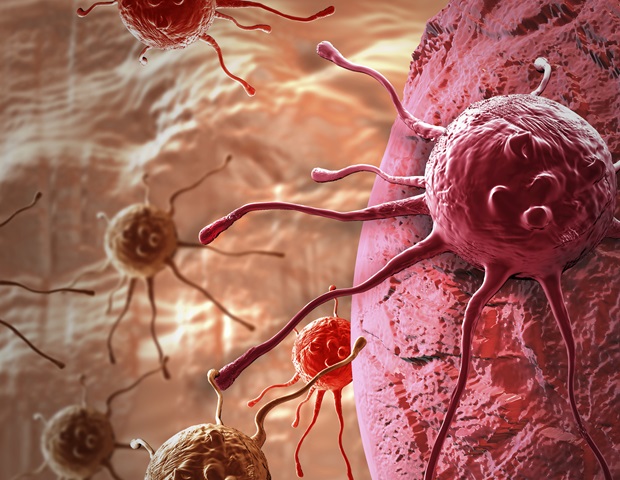
Circulating tumor cells (CTCs) confer with most cancers cells which have damaged off from a major tumor. These tumor cells can journey via the blood within the circulatory system and lodge themselves in different organs to trigger secondary tumors. Due to this fact, the detection and subsequent characterization of CTCs from blood may help within the medical analysis and therapy of varied cancers. Nonetheless, the environment friendly seize of CTCs from blood has been confirmed to be troublesome.
Developments in micro/nanofabrication applied sciences, together with newer polymer-based supplies, have given rise to microfluidic methods that may detect CTCs. Current studies point out that by using antibodies as seize molecules, CTCs might be trapped inside the microfluidic methods. However then once more, incorporating antibodies into particular areas inside micro-sized units requires complicated chemical reactions and finally will increase the prices of manufacturing CTC-sensing microdevices on a big scale.
To allow the environment friendly seize of CTCs from blood through a cheap sensing platform, a group of scientists led by Professor Masumi Yamada from the Graduate Faculty of Engineering, Chiba College, Japan, has developed novel microfluidic units that incorporate microcones, comparable in dimension to organic cells. The group comprised Mr. Yuhei Saito from the Graduate Faculty of Science and Engineering, Chiba College, and Dr. Shuhei Aoyama from Denka Innovation Middle, Denka Co., Ltd., Japan. Their analysis findings had been revealed on-line within the journal Lab on a Chip on Could 28, 2025.
Initially, the researchers utilized polycarbonate (PC) sheets with the microcone arrays with nanometer-sized roughness by using thermal nanoimprint lithography (T-NIL)-a heat-based fabrication know-how. Particularly, T-NIL allowed the preparation of microcones that had been round 30 micrometers in dimensions and packed in a hexagonal sample. Owing to their floor chemistry- and morphology-based interactions, the micro/nanoengineered PC sheet might simply bind to and adsorb antibodies.
To develop a useful microdevice, the scientists coated the fabricated PC sheets with anti-human epithelial cell adhesion molecule antibodies, which might seize most cancers cells. The PC sheets had been then sandwiched between a flat plate and a glass slide to type microfluidic channels. “To analyze the impression of the microcone association on the seize behaviors of the most cancers cells, we managed the orientation angles of the microcone array within the microgap channels,” says Prof. Yamada, offering finer particulars in regards to the examine.
Throughout experimental evaluation, the microfluidic gadget demonstrated extremely selective seize of human breast most cancers (MCF-7) cells and human lung most cancers (A549) cells from the blood samples. Notably, in units the place the orientation angles of microcones had been 15° or 30°, the seize effectivity of MCF-7 cells remained greater than 90% even at excessive stream charges. This discovering confirmed that the microcone association was key to the sensing purposes of the microfluidic gadget.
Lastly, to focus on the medical diagnostic functionality of the gadget, the researchers carried out an immunostaining examine utilizing fluorescent dyes to detect particular proteins. Regardless of utilizing a number of reagents to fluorescently label cells, they discovered that the most cancers cells remained trapped inside the micro-channels and didn’t escape. Furthermore, throughout commentary below fluorescent gentle, the captured most cancers cells might be simply distinguished from the traditional cells.
Prof. Yamada concludes by describing the potential purposes of the novel microcone-containing diagnostic system, “There are a lot of applied sciences for detecting most cancers, but it surely has been a long-standing problem to detect most cancers cells with excessive sensitivity utilizing minimally invasive strategies. We hope that via our new microfluidic system, even easy blood checks might be utilized to assist within the early analysis of most cancers. It could even be helpful for verifying the effectiveness of most cancers therapy and monitoring recurrence after therapy.”
Taken collectively, this examine reveals a easy, cost-efficient, and extremely delicate diagnostic instrument to detect circulating most cancers cells in blood. Allow us to hope that this novel gadget shall be utilized in sensible settings sooner for the environment friendly analysis of most cancers.
Supply:
Journal reference:
Saito, Y., et al. (2025). Enhancing Most cancers Cell Immunocapture on Orientation-controlled Nanoimprinted Microcone Arrays in Microgap Channels. Lab on a Chip. doi.org/10.1039/d5lc00143a.